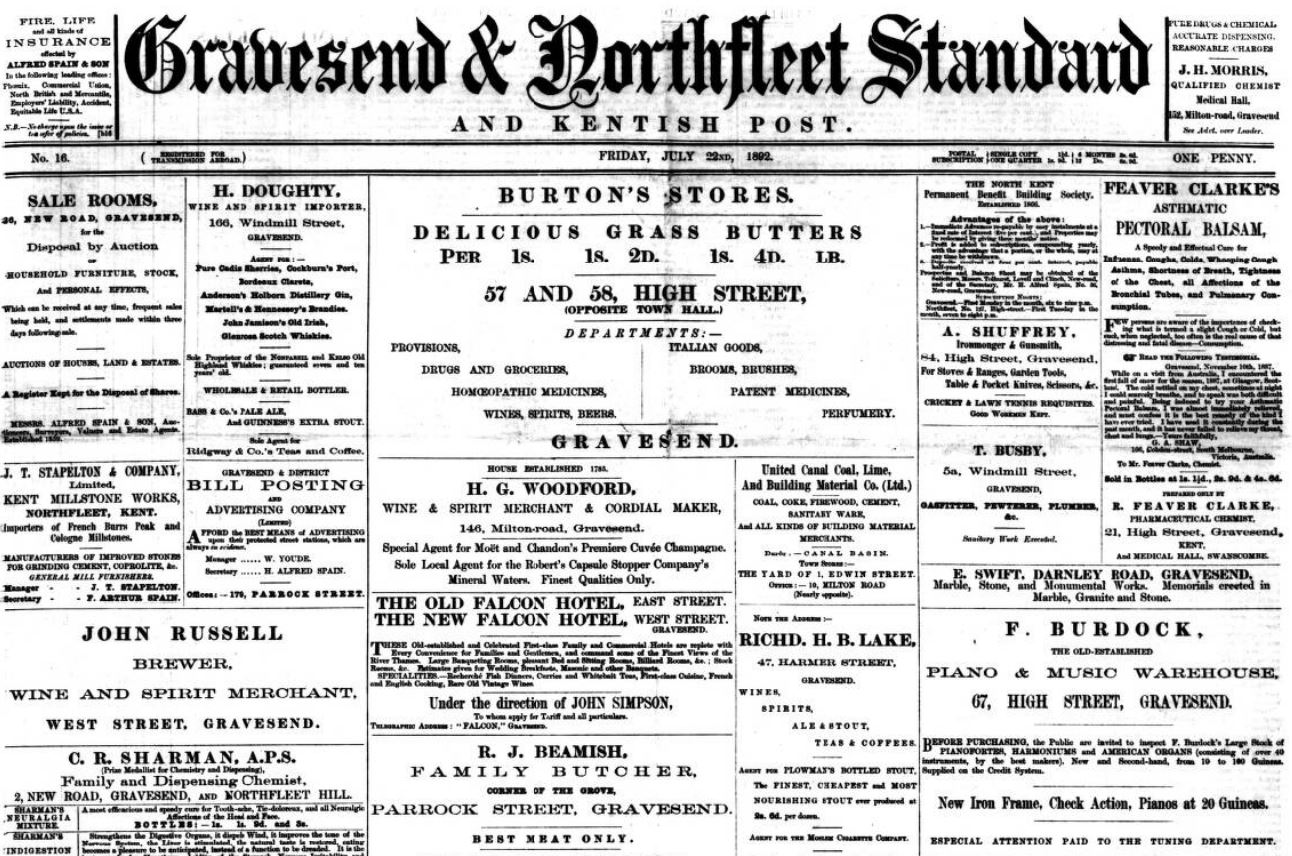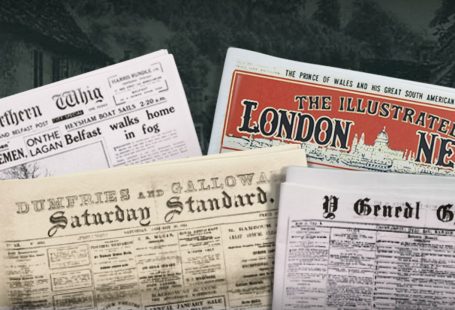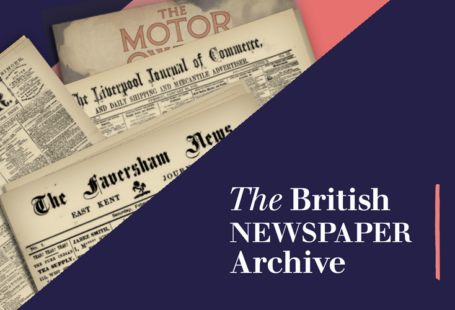This week at The Archive we are delighted to have added 54,622 brand new pages, with four brand new titles joining us over the past seven days alone.
From Glamorgan to Gravesend, from Sussex to Staveley, read on to discover more about our brand new titles of the week, and also to find out more about the significant updates we have made to our existing titles from England and Wales. Plus, we use our new newspapers to understand more about early attitudes to fingerprinting as a method of solving crime.
Register now and explore the Archive
Our largest new newspaper of the week is the Eckington, Woodhouse and Staveley Express. This weekly newspaper was first published on 2 April 1897 and appeared every Saturday. Printed by W.P. Turner in the Derbyshire market town of Eckington, it covered the local area of north east Derbyshire, and the south of Yorkshire. We have added just over 24,000 pages to this title, which closed in 1940.
Eckington, Woodhouse and Staveley Express | 16 February 1907
From its first edition you could find photographs of local news events, as well as detailed descriptions of local political and parish meetings. The Express contained such sections as ‘Sport and Play,’ ‘Bits from Books’ and witty and factual columns ‘Wise and Otherwise’ and ‘Words and Wisdom.’
We move further south for our next new title, the Gravesend & Northfleet Standard. This Kent-based title was first published on 8 April 1892, and was published in Gravesend. Its first edition described how it appeared:
…without any desire to injure existing newspapers in Gravesend; but because we feel there is plenty of room for such a paper as we intended to produce, we to-day launch ‘The Standard’ on its career.
Furthermore, the new publication promised that:
…we have the means, as we have the determination, to make this journal in the future fully worthy of the confidence of the ‘men and women of Kent.’
Gravesend & Northfleet Standard | 22 July 1892
With business as the newspaper’s ‘watchword,’ the publishers of the Gravesend & Northfleet Standard understood the necessity for paid advertising in keeping their publication afloat. Thus, you will find a variety of advertisements within its pages, as well as an eclectic mix of articles, from ‘Contemporary Chat’ to ‘Gardening Work for the Week,’ from ‘Fashions for the Week’ to the ‘Society Papers.’
Conservative in its politics, the Gravesend & Northfleet Standard also contained pieces pertinent to the local area, with local wills and bequests listed, as well as the latest from the school boards and police courts. You will also find in the newspaper ‘Hints for the Home,’ ‘Yankee Humour,’ and ‘Something for the Young Folks.’
Staying in the south of England now for our next new title, which was affectionately nicknamed The Squeaker. We are delighted to introduce to our collection the Hants and Sussex News, which was the Hampshire market town of Petersfield’s first ever newspaper. First published on 5 September 1883 as the Petersfield Weekly News by a Mr. F.D. Button, it became known as the Hants and Sussex News in 1892 after Arthur Wilson Childs became its proprietor.
Hants and Sussex News | 10 January 1910
Childs remained with the newspaper for another forty years, and the Hants and Sussex News last appeared on 29 August 1962, when it was incorporated with the Petersfield Post.
Within its pages you can find local news, with a column entitled ‘Town Talk,’ with news from nearby Hampshire towns and villages like Liss and Emsworth, and from across the border in West Sussex. Reflecting the main local industry of agriculture, the newspaper contained a ‘Field and Dairy Farming’ column, as well as features entitled ‘Gardening Gossip’ and ‘Literary Gleanings.’
Our final new newspaper of the week is the Glamorgan Advertiser. First published on 6 June 1919 in the mining town of Maesteg, this independent newspaper appeared every Friday. Its first edition stated its noble intentions:
The ‘Glamorgan Advertiser’ is not founded to boom any party or undertaking, nor is it bound to the promulgation of any dogma. It will be independent it its thoughts…We want the ‘Advertiser’ to be a People’s Paper, a vehicle of public opinion, a focus of local affairs…
Glamorgan Advertiser | 25 April 1924
With its course set on being both an independent and local paper, the Glamorgan Advertiser is a rich repository of local news, featuring such sections as ‘Local Intelligence, ‘Notes of Local Topics’ and ‘Glamorgan Gossip.’ It also featured general interest articles such as ‘Notes on Gardening’ and sporting news.
We have also made significant updates to another of our Welsh newspapers, namely the Flintshire County Herald, to which we have added over 20,000 new pages. The Flintshire County Herald covered the Welsh counties of Flintshire and Denbighshire, and was a truly regional paper, containing notices of births, marriages and deaths, as well as sensational local headlines such as ‘Fried Fish Causes Death.’
Stockton-on-Tees title the Northern Weekly Gazette also sees extensive updates to its pages this week. This County Durham-based newspaper was founded in 1859 with a Liberal stance, and appeared every Saturday priced at one penny.
Full details of all our new and updated titles can be found at the end of this blog.
Fingerprinting – ‘The Craze of the Future’
Although the use of fingerprints for identification purposes has ancient origins, with officials in ancient China using their fingerprints to sign documents, and fingerprints being used to sign written contracts in 200BC Babylon, in the modern era they only started to be used for solving crime in the late nineteenth and early twentieth centuries.
Newly added pages to the Northern Weekly Gazette, and pages from our new title the Gravesend & Northfleet Standard, demonstrate contemporary attitudes to fingerprints being used as a method of solving crime, with some at first sceptical, and others in favour.
But how did fingerprinting as we know it come about? The Northern Weekly Gazette, in its May 1905 article entitled ‘The Craze of the Future,’ offers us a short history:
It was not till 1823, however, that the scientific men of Europe really paid any attention to this subject. In that year Purkenje, an eminent physiologist, delivered his famous ‘Commentatio’ at the University of Breslau. He distinguished nine types of impressions, and suggested a system of classification. But his suggestions were not followed up.
Despite Czech anatomist and physiologist Jan Evangelista Purkyně being one of the most famous scientists of the day, he could not convince society of the value of fingerprinting. Fast-forward fifty years, and:
The first application of the finger-print system on a large scale was made by Sir William Herschel, of the Indian Civil Service, who, in 1877, introduced it into the district of Hooghly, in Bengal. He wrote a report recommending the adoption of the system, but his advice received but scant attention, and the practice lapsed in the Hooghly district after his departure.
But the practice continued in India, as the Northern Weekly Gazette tells us:
Mr E.R. Henry, then Inspector-General of the Police in the Lower Provinces of India… divides all the different kinds of impressions – ‘aches,’ ‘loops,’ ‘whorls,’ etc. – into two classes, which can be recognised at a glance, and his key makes everything plain. With the completed code the finger-print system became at once better and more serviceable.
Henry was assisted largely in the creation of this system by Kolkata fingerprint office employees Azizul Haque and Hem Chandra Bose, and by the early twentieth century, with input from scientists across the world, fingerprint evidence was slowly beginning to be used to solve crime.
Illustrated London News | 6 August 1910
But not everybody was convinced of its efficacy. In an article entitled ‘The Study of Thumb Prints‘ in the Gravesend & Northfleet Standard, 18 August 1900, the writer is largely sceptical of the practice:
It is a pretty idea; but when we remember that the daily average of our prisons is over fourteen thousand, it becomes evident that the chances of detection by this means is rather remote.
He worries that the size of the criminal population would make the fingerprint system impossible to enact, whilst also impacting the privacy of a felon:
We have only to consider the figures that represent the year’s crime to realise the size of such an undertaking. Besides, it is open to question whether there is any advantage in marking down criminals in this fashion…It is the old story of a dog with a bad name, and it might be a good thing for the morals of the land if it were made a punishable offence for one man to remind another that he had been in prison.
But even he can see some benefits, for its use in ‘cases where identification is needed…the thumb-print is of far greater value than the photograph.’
Illustrated London News | 19 October 1907
By 1902 the Northern Weekly Gazette is reporting on the success of fingerprinting as a method for solving crime. Four years previously, in 1898, ‘the manager of a tea-garden in the district of Jalpaiguri, on the Bhutan frontier, was found on his bed with his throat cut. His despatch-box and safe had been rifled, and a quantity of rupees carried off.’
The main suspect was a former servant of the manager, but he had not been seen in the area for some time. However, fingerprints found on a calendar inside the despatch box were proved to be his, and the former servant, Kangali Charan, was ‘put on trial, charged with murder and theft, and convicted.’
By August 1905 the Northern Weekly Gazette is recognising the benefits of fingerprinting in preventing the innocent being convicted, for via fingerprinting ‘such injustice will not much longer prevail.’
The article goes on to describe how the London police had been using fingerprinting:
In 70,000 impressions taken by the London police, no two were exactly alike…It is quite possible to keep a collection of hundreds and thousands of finger-prints, as will soon be the case at the police headquarters where the dossiers of habitual criminals are preserved in such a fashion that a very few minutes suffice to file a new print in its proper place, and to determine whether it coincides with any already in the collection.
Illustrated London News | 6 August 1910
And the headlines showed that the system was already working. The Gravesend & Northfleet Standard, 26 August 1905, reports how:
An Englishman arrested in Copenhagen while trying to change some of the banknotes that formed part of the £3,200 stolen from a clerk in Liverpool has been identified by his finger-prints as a dangerous criminal, who has undergone many terms of imprisonment for fraud.
Illustrated London News | 6 August 1910
And again, on 25 August 1906, under the headline ‘Traced by Finger-Prints:’
…John Whelan, twenty three, labourer, was charged with theft from a tobacconist’s shop, it was stated that the premises were entered on July 7th, and a large quantity of tobacco stolen. On August 6th the police secured the finger impressions of a man on a piece of glass in the shop, and those were compared with the records in the possession of the police, and the identity of the prisoner established.
Whelan was committed to trial. And so, by this point in time, fingerprinting had revolutionised the detection of crime, but also forced a change in the carrying out of crime – now, every criminal intent on not getting caught, would be forced to wear gloves!
New Titles
Title |
Years Added |
| Eckington, Woodhouse and Staveley Express | 1897-1911, 1913-1940 |
| Glamorgan Advertiser | 1919-1949, 1951-1962 |
| Gravesend & Northfleet Standard | 1892-1895, 1898-1910, 1912-1915 |
| Hants and Sussex News | 1889-1892, 1895-1913 |
Updated Titles
This week we have updated seven of our existing titles.
You can learn more about each of the titles we add to every week by clicking on their names. On each paper’s title page, you can read a FREE sample issue, learn more about our current holdings, and our plans for digitisation.
Title |
Years Added |
| Atherstone, Nuneaton, and Warwickshire Times | 1885-1888, 1890-1891 |
| Blandford and Wimbourne Telegram | 1880-1883 |
| Flintshire County Herald | 1887-1895, 1898-1910, 1912-1947 |
| Haslingden Gazette | 1916-1926 |
| Northern Weekly Gazette | 1905, 1907-1909, 1914-1916, 1932 |
| Penistone, Stocksbridge and Hoyland Express | 1898-1907, 1926 |
| Stockton Herald, South Durham and Cleveland Advertiser | 1890 |
You can keep up to date with all the latest additions by visiting the recently added page. You can even look ahead to see what we’re going to add tomorrow.
















